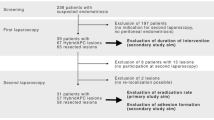Abstract
Introduction
The PlasmaJet (PJ) coagulator uses neutral pure argon plasma to achieve coagulation. Helica thermal coagulator (HTC) achieves coagulation with helium gas. HTC is currently used in the treatment of mild to moderate endometriosis.
Objective
The objective of this study was to compare the tissue damage caused by PJ to the HTC in the uterus, ovary and fallopian tube. Our hypothesis was that PJ is a safe technology to use and the tissue damage caused is comparable to HTC.
Methods
Fifteen subjects undergoing hysterectomy with or without salpingo-oophorectomy were prospectively recruited for in vivo assessment of the two instruments. Both instruments were used on a small area of uterus, ovary and fallopian tube following the ligation of uterine artery pedicle. PJ was used at a power setting of 20 % for duration of 5 s at a clinically acceptable distance of 0.5 to 1 cm from the tissue surface. HTC was used at a widely accepted low power setting in the treatment of endometriosis for a similar duration and distance. Tissue damage was evaluated histologically. ANOVA was used to compare the mean differences.
Results
Data were normally distributed. Five subjects had a subtotal hysterectomy and 10 had hysterectomy with salpingo-oophorectomy. A total of 15 uteri, 10 ovaries and 10 fallopian tubes were histologically analysed for the tissue effect of PJ and HTC. There was no significant difference in the mean ± SD depth of tissue damage seen between PJ and HTC in the uterus (0.63 ± 0.19 vs. 0.68 ± 0.18; P = 0.481), ovary (0.61 ± 0.14 vs. 0.67 ± 0.15; P = 0.420) and fallopian tube (0.63 ± 0.18 vs. 0.60 ± 0.13; P = 0.688). A significantly lesser lateral spread of tissue damage (width) was seen with PJ than HTC in all three tissue types (uterus: 4.66 ± 0.91 vs. 7.67 ± 1.21, P < 0.001; ovary: 4.05 ± 0.61 vs. 5.90 ± 0.95, P < 0.001; fallopian tube: 4.50 ± 0.77 vs. 6.00 ± 1.28, P = 0.034).
Conclusion
The depth of tissue damage caused by PJ at 20 % power is comparable to that with HTC on gynaecological tissues. The lateral spread (width of tissue damage) is however lesser with PJ than with HTC.



Similar content being viewed by others
References
Grund KE, Straub T, Farin G (1999) New haemostatic techniques: argon plasma coagulation. Baillieres Best Pract Res Clin Gastroenterol 13(1):67–84
Iannelli A, Schneck AS, Gugenheim J (2010) Use of the PlasmaJet system in patients undergoing abdominal lipectomy following massive weight loss: a randomized controlled trial. Obes Surg 20(10):1442–1447
Gugenheim J, Bredt LC, Iannelli A (2011) A randomized controlled trial comparing fibrin glue and PlasmaJet on the raw surface of the liver after hepatic resection. Hepatogastroenterology 58:922–925
Seitz U, Seewald S, Bohnacker S, Soehendra N (2003) Advances in interventional gastrointestinal endoscopy in colon and rectum. Int J Colorectal Dis 18(1):12–18
Kozlov KK, Shaliapin VG, Mamontov VV, Filippov AA, Ostroukhov NF, Korzhuk MS, Pilipenko AP (2003) The application of an impulse plasma jet for trauma of the liver. Vestn Khir Im I I Grek 162(2):42–45
Bourdel N, Roman H, Mage G, Canis M (2011) Surgery for the management of ovarian endometriomas: from the physiopathology to the pre-, peri- and postoperative treatment. Gynecol Obstet Fertil 39(12):709–721
Donaldson K, Hawthorn R (1995) Laparoscopic use of the Helica thermal coagulator. Helica thermal coagulator medical reports http://www.helica.co.uk/medicalrepons.html, pp 1–3
Cumming G, Philips K (1994) Another wave at an old chestnut: the helium beam coagulator in the treatment of endometriosis. Helica thermal coagulator medical reports
Deb S, Deen S, Ashford KS et al (2010) Histological quantification of the tissue damage caused by PlasmaJet™ coagulator. IOP publishing plasma surgicals web. http://www.plasmasurgical.com/resource.html
Sonoda Y, Olvera N, Chi DS, Brown CL, Abu-Rustum NR, Levine DA (2009) Pathologic analysis of ex vivo plasma energy tumour destruction in patients with ovarian or peritoneal cancer. Abstract, Society of gynaecologic oncologists, 2009. IOP publishing plasma surgicals web. http://www.plasmasurgical.com/resource.html
Turvill JL, Domizio P. Assesment of the Helica TC in vivo: effect of duration of exposure and power setting on tissue injury. Helica thermal coagulator medical reports. http://www.helica.co.uk/medicalrepons.html
Madhuri K, Papatheodorou D, Taylor A et al (2010) First clinical experience of argon neutral plasma energy in gynaecological surgery in the UK. Gynecol Surg 7:423–425
Conflict of interest
None.
Author information
Authors and Affiliations
Corresponding author
Rights and permissions
About this article
Cite this article
Deb, S., Sahu, B., Deen, S. et al. Comparison of tissue effects quantified histologically between PlasmaJet coagulator and Helica thermal coagulator. Arch Gynecol Obstet 286, 399–402 (2012). https://doi.org/10.1007/s00404-012-2302-x
Received:
Accepted:
Published:
Issue Date:
DOI: https://doi.org/10.1007/s00404-012-2302-x




